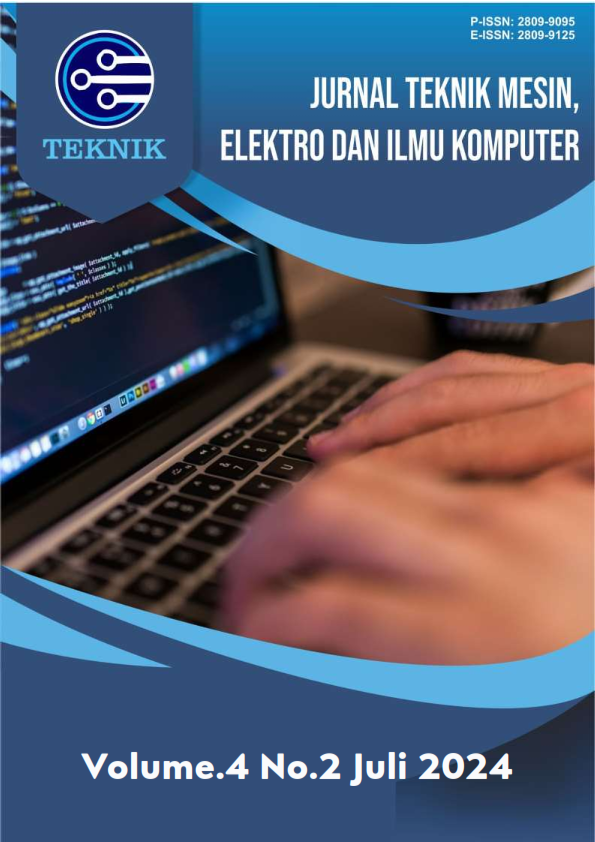Rancang Bangun Alarm Gempa Menggunakan Mikrokontroler ESP8266 Berbasis Android
DOI:
https://doi.org/10.55606/teknik.v4i2.5697Keywords:
Earthquake, ESP8266-Microcontroller, Piezoelectric, Sensor, AndroidAbstract
Earthquakes are natural disasters that can occur without warning. Earthquakes originate from vibrations in the earth's bowels that spread to the surface caused by cracks in the earth breaking and shifting violently. Anticipating the impact of an Earthquake can be done using an ESP8266 Microcontroller which is integrated with a Piezoelectric Sensor as the Main Sensor. The Piezoelectric Sensor output is sent and saved to a MySQL Database with test parameters in the form of object weight and distance. The output data results are processed in the form of Java Script Object Notation (JSON) and described by Android. The testing stage was carried out using stones weighing 1 kg, 3kg and 5kg and distances of 25cm, 50cm and 75cm. The results of the tool testing produced a vibration value with the lowest value being 24 and the highest value being 601. Earthquake detection is divided into three categories, namely weak, moderate and strong, based on sensor reading values. The weak category is set in the value range 24-106, moderate in the range 107-199, and strong for reading values above 200.
References
Ade, S., & Fitriyanti, F. (2017). Rancang bangun aplikasi kunci pintu otomatis berbasis mikrokontroler Arduino menggunakan smartphone Android. Journal of Computer Engineering System and Science, 2(2), 59–63.
Alif, G., Murti, M. A., & Nugrah, R. (2018). Perancangan alat pendeteksi gempa menggunakan sensor getar. e-Proceeding of Engineering, 5(3), 4028–4035.
Aryunita, F., Rasjid, N., & Mansyur, M. F. (2024). Rancang bangun sistem monitoring keamanan kandang ayam broiler menggunakan ESP32-CAM berbasis IoT dengan aplikasi Android. JITET (Jurnal Informatika dan Teknik Elektro Terapan), 12(1), 246–254.
Effendi, R., Kania, R., & Muhammad, M. (2021). Rancang bangun pendeteksi getaran gempa berbasis mikrokontroler IoT Arduino. Journal of Innovation and Future Technology, 3(2), 41–55.
Giyartono, A., & Kresnha, P. E. (2015). Aplikasi Android pengendali lampu rumah berbasis mikrokontroler Atmega328. Seminar Nasional Sains dan Teknologi, 1–9.
Herdiana, Y. (2014). Aplikasi rumus matematika SMA berbasis mobile. Jurnal Ilmiah Komputer dan Informatika (KOMPUTA).
Nur, A. M. (2010). Gempa bumi, tsunami dan mitigasinya. Jurnal Geografi, 66–73.
Pamungkas, K. A., Novianti, T., & Aziz, A. (2016). Aplikasi Android dan mikrokontroller Arduino pada kontrol smart home dengan komunikasi Bluetooth. Jurnal Ilmiah NERO, 2(3), 197–203.
Prasetio, F. B., & Wellem, T. (2022). Perancangan dan implementasi aplikasi Android untuk layanan informasi pariwisata. Jurnal Penerapan Teknologi Informasi dan Komunikasi, 1(2), 114–132.
Satrianto, F. W., Budiman, G., & Setiadi, B. (2016). Sistem keamanan berbasis Android vehicle tracking dengan mikrokontroler. e-Proceeding of Engineering, 3(1), 486–493.
Siswanto, S., Ngatono, & Saputra, S. F. (2022). Prototype sistem peringatan dini bencana gempa bumi dan tsunami berbasis Internet of Things. Jurnal PROSISKO, 9(1), 60–66.
Sulistyorini, T., Sofi, N., & Sova, E. (2022). Pemanfaatan NodeMCU ESP8266 berbasis Android (Blynk) sebagai alat mematikan dan menghidupkan lampu. JUIT, 1(3), 40–53.
Sumarsono, & Saptaningtyas, D. W. (2018). Pengembangan mikrokontroler sebagai remote control berbasis Android. Jurnal Teknik Informatika, 11(1), 67–74.
Zulharbi, Z., Firdaus, F., Antonisfia, Y., & Defit, S. (2014). Implementasi moving average filter pada mikrokontroler sebagai peredam noise sensor piezo elektrik untuk mendeteksi gelombang seismik (gempa bumi). Seminar Nasional Sains dan Teknologi, 1–8.
Downloads
Published
How to Cite
Issue
Section
License
Copyright (c) 2025 Jurnal Teknik Mesin, Elektro dan Ilmu Komputer

This work is licensed under a Creative Commons Attribution-ShareAlike 4.0 International License.








